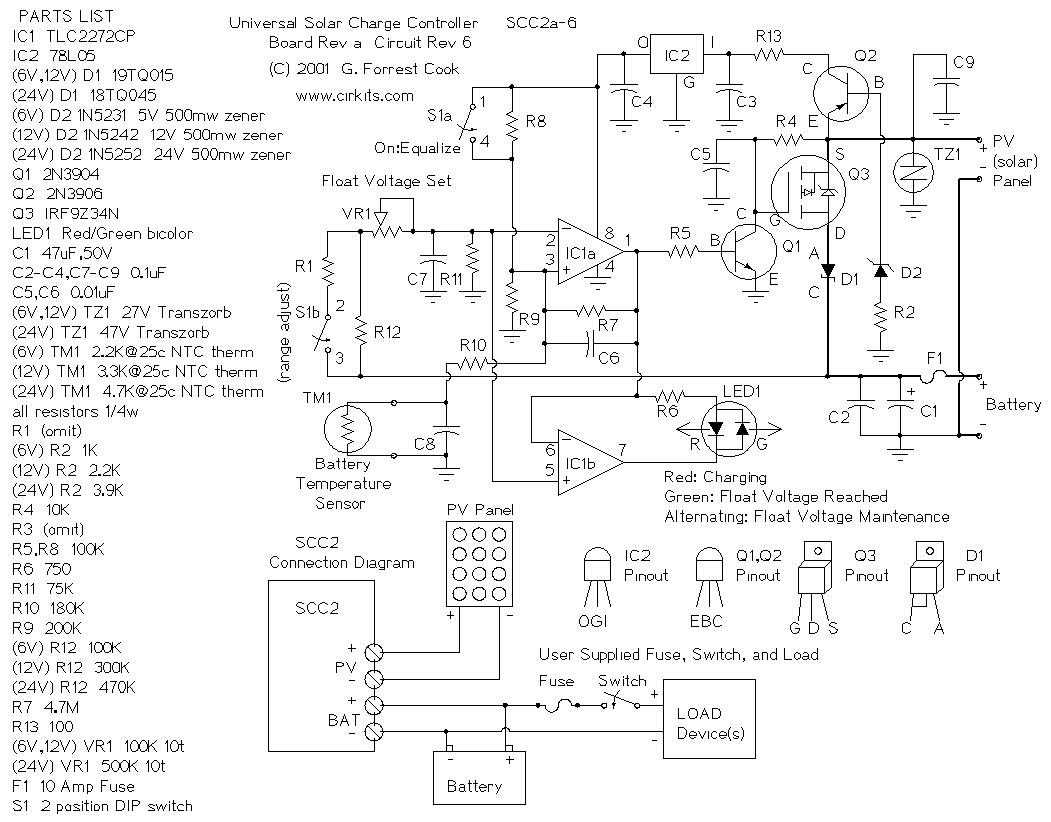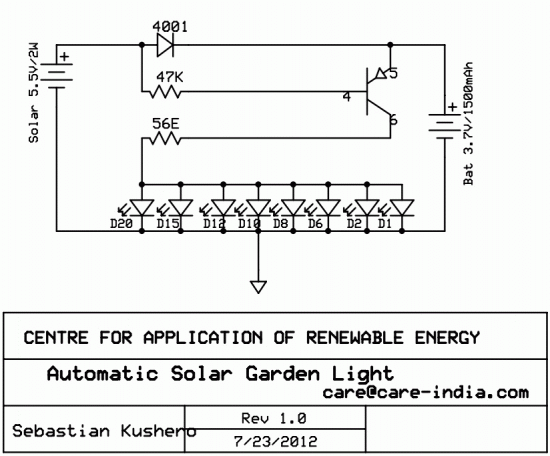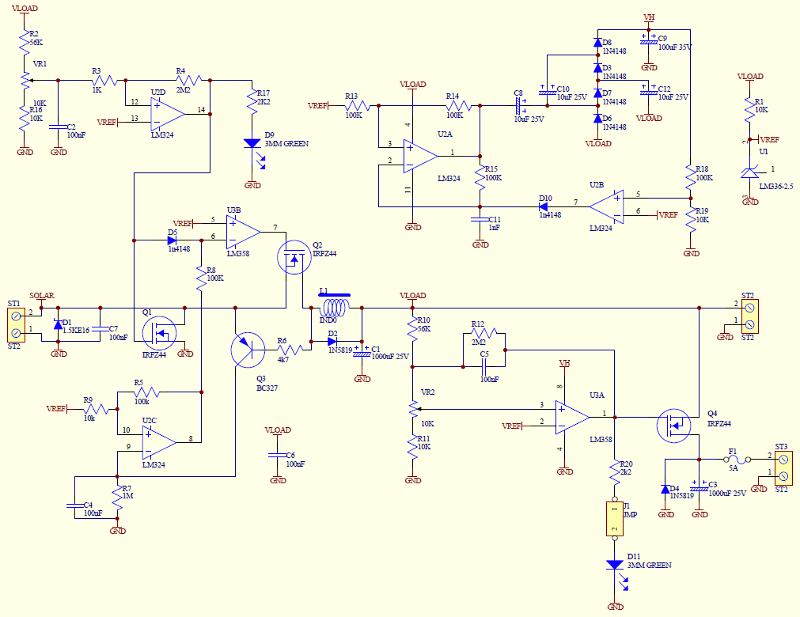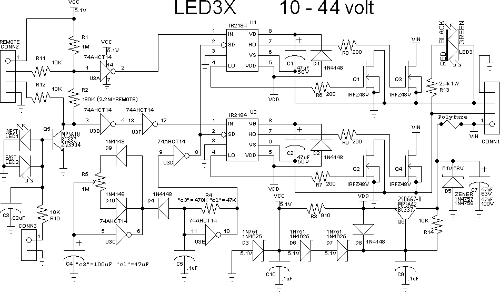
solar tracker 6221A
This circuit controls a stepper motor using an L6221A integrated circuit (IC). A power supply from a printer can be utilized to provide the necessary DC voltages. All ground pins on the Centronics connector should be connected to ground. Caution is advised when connecting the system to a PC, as the parallel port can be easily damaged due to incorrect connections. It is recommended to purchase an inexpensive I/O card with a parallel port for use with the tracker. The L6221A chip is commonly found in older inkjet printers and can also be adapted from a floppy drive printed circuit board (PCB). Additional resources are available online that explain the fundamentals of using a PC's parallel port to control a stepper motor. Currently, there is no customized software available for operating the Canuckle solar tracker, and any information regarding existing programs on the internet would be appreciated.
The circuit described utilizes the L6221A IC, which is a dual full-bridge driver designed for controlling stepper motors. This IC allows for precise control of the motor's rotation direction and speed by varying the input signals. The use of a printer's power supply is advantageous, as it provides a readily available source of DC voltage, typically in the range of 5V to 12V, suitable for driving the L6221A.
To ensure proper operation, all ground connections from the Centronics connector must be tied to the system ground. This is essential for maintaining a common reference point for all signals and preventing potential ground loops that could lead to erratic behavior or damage to the components.
When interfacing with a PC's parallel port, caution is paramount. The parallel port is sensitive to incorrect wiring and voltage levels; therefore, it is advisable to use an inexpensive I/O card that can safely handle the connections without risking damage to the computer's motherboard. This card should be capable of translating the parallel port signals into appropriate control signals for the L6221A.
The L6221A can control the stepper motor by energizing the coils in a specific sequence, allowing for controlled stepping. The sequence of signals sent from the parallel port to the L6221A will determine the stepper motor's direction and speed. For those looking to adapt a floppy drive PCB, it is important to ensure that the connections to the motor and power supply are correctly configured to match the specifications of the L6221A.
While no dedicated software is currently available for operating the Canuckle solar tracker, users are encouraged to explore existing resources and forums that may provide insights or code examples for controlling stepper motors via parallel ports. Websites like Code Projects can be valuable for understanding the programming required to implement such control systems. By leveraging community knowledge and existing software solutions, users can develop a functional control system for the solar tracker.This circuit controls a stepper motor with a L6221A IC. The power supply from a printer can be used to supply the DC voltages. Tie all the ground pins on the Centronics connector to ground. Be carfull when hooking up the system to your PC. The PC parallel port can be damaged quite easily if you make incorrect connections. A good idea is to buy an inexpensive I/O card which has a parallel port and use it for your tracker. The L6221A chip can be found in many older inkjet printers. You can also easily adapt a floppy drive PCB for the same purpose. Here is a good site that explains the basics of using a parrallel port of a PC to control a stepper motor. Code Projects. We do not have any customized software to run the Canuckle solar tracker as of yet. We would appriciate any information on any available program on the net. 🔗 External reference
The circuit described utilizes the L6221A IC, which is a dual full-bridge driver designed for controlling stepper motors. This IC allows for precise control of the motor's rotation direction and speed by varying the input signals. The use of a printer's power supply is advantageous, as it provides a readily available source of DC voltage, typically in the range of 5V to 12V, suitable for driving the L6221A.
To ensure proper operation, all ground connections from the Centronics connector must be tied to the system ground. This is essential for maintaining a common reference point for all signals and preventing potential ground loops that could lead to erratic behavior or damage to the components.
When interfacing with a PC's parallel port, caution is paramount. The parallel port is sensitive to incorrect wiring and voltage levels; therefore, it is advisable to use an inexpensive I/O card that can safely handle the connections without risking damage to the computer's motherboard. This card should be capable of translating the parallel port signals into appropriate control signals for the L6221A.
The L6221A can control the stepper motor by energizing the coils in a specific sequence, allowing for controlled stepping. The sequence of signals sent from the parallel port to the L6221A will determine the stepper motor's direction and speed. For those looking to adapt a floppy drive PCB, it is important to ensure that the connections to the motor and power supply are correctly configured to match the specifications of the L6221A.
While no dedicated software is currently available for operating the Canuckle solar tracker, users are encouraged to explore existing resources and forums that may provide insights or code examples for controlling stepper motors via parallel ports. Websites like Code Projects can be valuable for understanding the programming required to implement such control systems. By leveraging community knowledge and existing software solutions, users can develop a functional control system for the solar tracker.This circuit controls a stepper motor with a L6221A IC. The power supply from a printer can be used to supply the DC voltages. Tie all the ground pins on the Centronics connector to ground. Be carfull when hooking up the system to your PC. The PC parallel port can be damaged quite easily if you make incorrect connections. A good idea is to buy an inexpensive I/O card which has a parallel port and use it for your tracker. The L6221A chip can be found in many older inkjet printers. You can also easily adapt a floppy drive PCB for the same purpose. Here is a good site that explains the basics of using a parrallel port of a PC to control a stepper motor. Code Projects. We do not have any customized software to run the Canuckle solar tracker as of yet. We would appriciate any information on any available program on the net. 🔗 External reference





